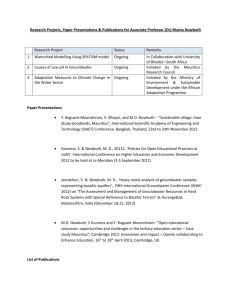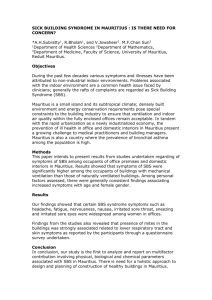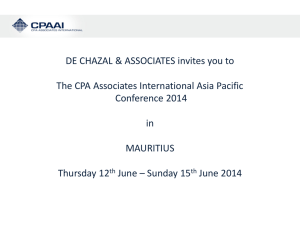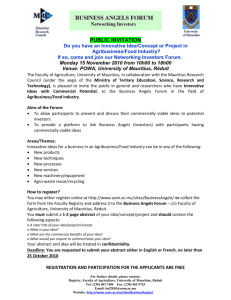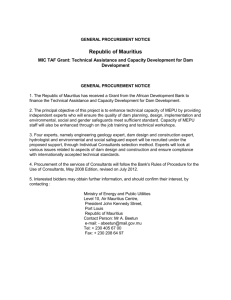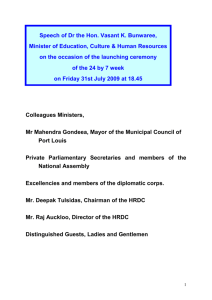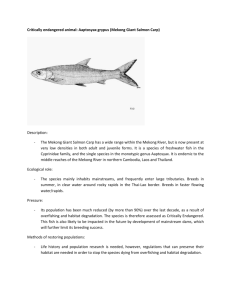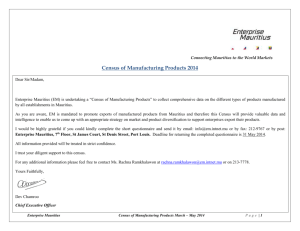Progress in economic conditions in Mauritius
advertisement
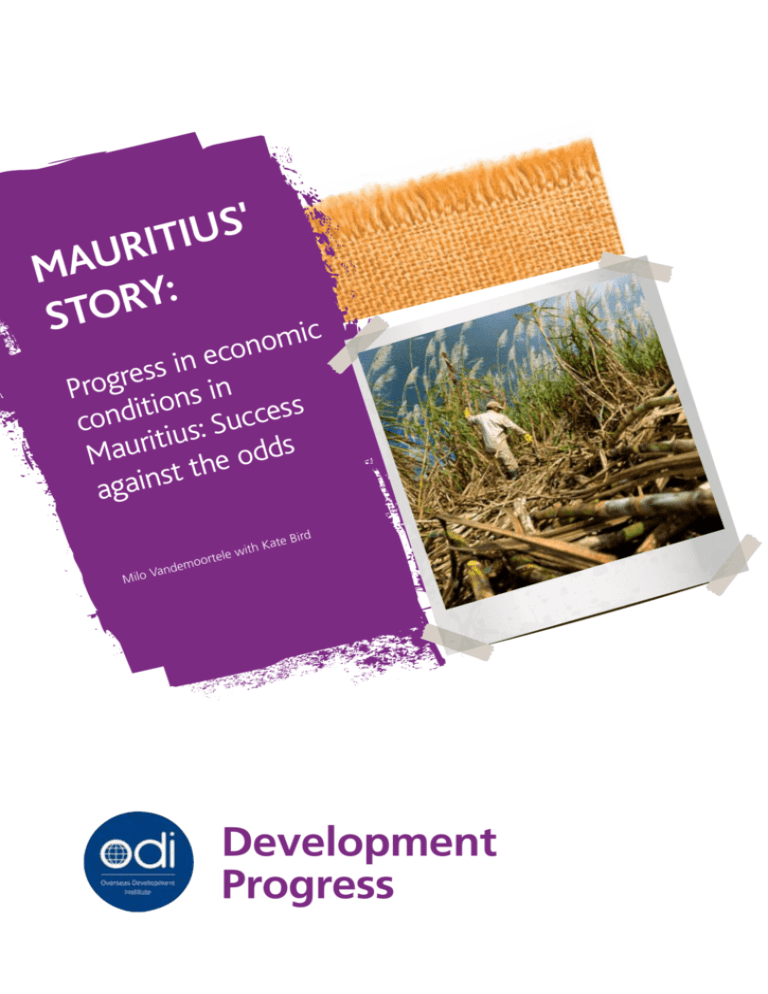
' S U I T I R U MA : Y R STO omic n o c e n si s e r g Pro ions in s t s i e d c n c o c Su : s u i t i Maur the odds st again Kate Bird r moo e Vand Milo ith tele w Development Progress Development Progress Progress in economic conditions in Mauritius: Success against the odds Key messages 1.Mauritius has achieved impressive and sustained progress in economic conditions. 2.Mauritius has also accomplished what few high-growth economies have achieved; reductions in inequality. Despite high growth between 1980 and 1996, inequality (as measured by the Gini coefficient) fell during the same time period. 3.Progress has been driven largely by an export-oriented approach, underpinned by a pragmatic set of liberalisation and diversification policies and strong government intervention. High and equitable public investment in human development have helped maintain the country’s competitive advantage and enabled it to take advantage of international markets and diversify. Development Progress stories e, c n e d n e p e d n i “ Since d e v e i h c a s a h Mauritius n i s s e r g o r p d e sustain ” . s n o i t i d n o c economic 1 WDI database. 2 1980 data: UNU-WIDER WIID; 2006 data: Household Budget Survey 2006/07. 3 MDG Database. 4 Ibid. 5 UNDP (2008) Human Development Report 2009. New York: UNDP. 1.0 OECD 0.9 CEE and CIS Latin American and Caribbean Mauritius East Asia and Pacific 0.8 Million Arab States 0.7 South Asia 0.6 Sub-Saharan Africa 0.5 2005 2000 0.4 1995 Mauritius has achieved what few other sub-Saharan African countries have been able to achieve since independence – sustained progress in economic conditions. It has also accomplished what a minority of fast growing economies have achieved – reductions in inequality. Between 1977 and 2008, Mauritius averaged a 4.6% gross domestic product (GDP) growth rate, compared with a 2.9% average in sub-Saharan Africa.1 Over the same time period, its GDP per capita averaged $2,921 (constant 2000 US$), well above a sub-continent average of $540. It is also the only country in the region where household expenditure increased significantly between 1990 and 2008. Meanwhile, inequality (as measured by the Gini coefficient) fell from 45.7 to 38.9 between 1980 and 2006.2 Figure 1: HDI trends, 1980-20055 1990 What has been achieved? Its performance on the Human Development Index (HDI), which draws on data on income, education and health to form a composite index, has been exceptional – not only by sub-Saharan African standards but also by international standards when compared with South Asia, the Arab States and East Asia and the Pacific, performing on a par with Latin America and the Caribbean (Figure 1). 1985 Despite multiple factors stacked against it, Mauritius has achieved stellar progress in economic conditions, and has been unique in its ability to take advantage of privileged access to international markets to develop in a sustained and equitable manner. This has been enabled and complemented by effective poverty reduction and equitable improvements in human development. These achievements have been made by means of: a concerted strategy of nation building; strong and inclusive institutions; high levels of equitable public investment in human development; and a pragmatic development strategy. 1980 At independence, Mauritius did not appear predestined for the progress that followed. Challenges included: extreme cultural diversity as well as racial inequality; power concentrated in a small elite; high unemployment; and high population growth. The country suffered from an economic crisis throughout the 1970s, was remote from world markets and was commodity dependent. It also exhibited low initial levels of human development. Mauritius has successfully translated economic growth into concrete poverty reduction and improvements in human development. Its poverty rates remain low by international standards, with less than 1% of the population estimated as living on less than $1 a day. Malaria has been successfully eradicated from the island, and life expectancy at birth increased from 61 overall in 1965 to 69.3 for men and 76.1 for women in 2008. The country has maintained a primary net enrolment ratio several points above 90% (93.3% in 1991 and 94.0% in 2009).3 Along with the Seychelles, it has the lowest under-five child mortality rate on the sub-continent (17 deaths out of 1,000 live births) and the highest rate of children immunised against measles (98% in 2008).4 HDI Summary What has driven change? A concerted strategy of nation building A concerted strategy of nation building in the early decades following independence set the foundations for sustained progress in Mauritius. This involved partnership among the major ethnic groups, a negotiated economic redistribution, a better balance of economic and political power and the building of strong institutions. These resulted in institutional arrangements that bolstered the emergence of a democratic developmental state to ensure economic redistribution and inclusive political representation. This included: • A constitutional mandate for the inclusion of minorities; • A system in the electoral process that ensures representation of ethnic groups, called the ‘best losers’ system, whereby an independent electoral commission appoints up to eight losing candidates to each new National Assembly to represent ‘underrepresented’ ethnic groups;6 • An inclusive party system that does not have an ethnic basis; and • A consultative approach to policy formation. These institutional arrangements have contributed to the establishment of strong and inclusive institutions, to high levels of equitable investment in social welfare and human development and to a pragmatic development strategy of heterodox liberalisation and policy continuity. These have all enabled effective structural changes to the Mauritian economy. Strong and inclusive institutions supporting a social consensus A key outcome of the state’s strategy was strong and inclusive institutions able to redistribute political and economic power away from the wealthy minority (Franco-Mauritian), in particular to disadvantaged ethnic groups.7 As one key informant from the Ministry of Finance noted: ‘This important determinant of growth, that is, the ability of our domestic institutions to manage the distributional conflicts, triggered by local and external shocks, stands out markedly in the case of Mauritius. The quality of our domestic institutions seems to override the other primordial factors affecting growth.’ Strong institutions have helped maintain the country’s competitiveness, economic resilience and stability. They have supported development strategy and ensured that quota rents from international markets are reinvested in strategic and productive sectors. They have also promoted a strongly regulated and well-capitalised banking and financial system, thus shielding it from toxic assets prior to the 2008 global economic crisis. High levels of equitable public investment in human development Independent Mauritius inherited a system of free education and health services. The government, as part of its strategy of nation building, avoided social and political tensions and supported solidarity and equity by investing in these social services, as well as a non-contributory basic retirement pension and an extensive set of social security schemes. Since then, it has expanded these services, with the aim of expanding opportunities for its population and ensuring inclusive growth. An unemployed, educated and easily adaptable labour force was an essential input into the success of the export-oriented strategy of the 1980s.8 Mauritians responded to opportunities with vigour: after the establishment of the export processing zone (EPZ), around 90% of entrepreneurs there and in the manufacturing sector were Mauritian nationals.9 Businessmen and women had the human capital, the know-how and the education to exploit market opportunities. The social infrastructure underpinning the flexible labour force was crucial to this. 6 Sandbrook, R. (2005) ‘Origins of the Democratic Developmental State: Interrogating Mauritius.’ Canadian Journal of African Studies 39(3): 549-581. 7 Sriskandarajah, D. (2005) ‘Development, Inequality and Ethnic Accommodation: Clues from Malaysia, Mauritius and Trinidad and Tobago.’ Oxford Development Studies 33(1): 63-79. 8 Subramanian, A. (2009) The Mauritian Success Story and Its Lessons. Helsinki: UNU-WIDER. 9 Interview, Ministry of Finance. Development Progress stories ns o i t i d n o c c i m o n o c e n i s s e r g t “Pro r o p x e n a y b y l e g r a l n e v i r was d ” . h c a o r p p a oriented A pragmatic development strategy of heterodox liberalisation and diversification Progress in economic conditions was driven largely by the export-oriented approach, underpinned by a heterodox set of liberalisation policies. The Mauritian government has played a strong and interventionist role: it has acted as facilitator (of the enabling environment for the private sector); as operator (to encourage competition); and as regulator (to protect the economy as well as vulnerable groups and sectors from shocks). A key strength is that leaders did not persist if a strategy did not work.10 There has also been consistency and stability in the approach to economic management, regardless of which political party is in government. Liberalisation occurred in phases, adapted to the country’s evolving advantages on the international market. In a first phase (1970s), Mauritius profited from sugar rents and established an EPZ. It also successfully attracted capital and foreign investment in manufacturing. A second phase (1980s-1990s) entailed the expansion of the EPZ and a significant increase in foreign direct investment (FDI) and tourism. Rents accruing from preferential access to markets for sugar and clothing together amounted to 7% of GDP in the 1980s and 4.5% in the 1990s.11 Capital and current accounts were liberalised, contributing to an investment and employment boom, and the high inflow of FDI brought with it managerial know-how and market access. A third phase (1990s-2010) consisted in broadening and deepening economic development through further diversification, liberalisation and investment. Lessons learnt • R econciling high economic growth with reductions in inequality is possible – in this case with resolute and pragmatic government leadership, complemented by strong institutions and equitable investments in human well-being. • A pragmatic development strategy was adopted: the liberalisation process was sequenced and tailored to the country’s competitive advantages and weaknesses, as well as to its political economy. This has contributed to impressive economic progress. • Strong human capital foundation, achieved through consistent and equitable investment in human development, enabled Mauritius to exploit advantages and maintain competitiveness in a fast evolving international market. • A concerted strategy of nation building put the institutional and infrastructural foundations in place to overcome several of the odds stacked against Mauritius. Strong institutions enabled the redistribution of political and economic power across ethnic groups. • Key challenges remain: inequality is now rising, particularly between ethnic groups, with increasing dominance of economic over political powers; the country’s competitive advantage on the international market is shrinking; microeconomic developments threaten to undermine medium- and long-term macroeconomic progress; and climate change and sea-level rises are posing risks to the sustainable development of small island developing states. 10 Ibid. 11 Subramanian (2009). Development Progress stories This brief is an abridged version of a research paper and is one of 24 development progress stories being released at www.developmentprogress.org The development progress stories project communicates stories of country-level progress from around the world, outlining what has worked in development and why. The project showcases examples of outstanding progress across eight main areas of development. You can find out more about the project, methodology and data sources used at www.developmentprogress.org This publication is based on research funded by the Bill & Melinda Gates Foundation. The findings and conclusions contained within are those of the authors and do not necessarily reflect positions or policies of the Bill & Melinda Gates Foundation. Photo credits from top to bottom istock/ Patrick Laverdant. Mauritius Flicrk/Massimo Ankor. Mauritius istock/ Patrick Laverdant. Mauritius istock/ Mauritius istockphoto/ Santosha. Mauritius Overseas Development Institute 111 Westminster Bridge Road London SE1 7JD United Kingdom Tel:+44 (0)20 7922 0300 Fax:+44 (0)20 7922 0399 Overseas Development Institute ODI is the UK’s leading independent think tank on international develop­ment and humanitarian issues. ODI holds the copyright for all ODI publications, which are subject to UK copyright law. ODI welcomes requests for permission to reproduce and disseminate its work, as long as they are not being sold commercially. As copyright holder, ODI requests due acknowledgement and a copy of the publication. The views presented in this paper are those of the authors and do not necessarily represent the views of ODI. © Overseas Development Institute 2010
